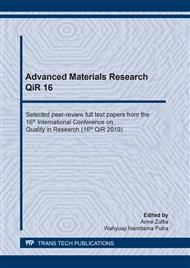[1]
A. M. Adel, A. A.El-Gendy, M. A. Diab, R. E. Abou-Zeid, W. K. El-Zawawy, A. Dufresne, Microfibrillated cellulose from agricultural residues. Part I: Papermaking application. Industrial Crops and Products, 93 (2016) 161-174.
DOI: 10.1016/j.indcrop.2016.04.043
Google Scholar
[2]
H. Liimatainen, J. Sirviö, A. Haapala, O. Hormi, J. Niinimäki, Characterization of highly accessible cellulose microfibers generated by wet stirred media milling. Carbohydrate Polymers, 83 (2011) 2005-2010.
DOI: 10.1016/j.carbpol.2010.11.007
Google Scholar
[3]
A. M. Adel, Z. H. A. El–Wahab, A. A. Ibrahim, M. T. Al–Shemy, Characterization of microcrystalline cellulose prepared from lignocellulosic materials. Part I. Acid catalyzed hydrolysis. Bioresource technology, 101 (2010) 4446-4455.
DOI: 10.1016/j.biortech.2010.01.047
Google Scholar
[4]
A. M. Adel, Z. H. A.El-Wahab, A. A. Ibrahim, , M. T. Al-Shemy, Characterization of microcrystalline cellulose prepared from lignocellulosic materials. Part II: Physicochemical properties. Carbohydrate Polymers, 83 (2011) 676-687.
DOI: 10.1016/j.carbpol.2010.08.039
Google Scholar
[5]
H. A. Krässig, Cellulose-structure. Accessibility and Reactivity. Gordon and Breach Science Publishers, Yverdon, (1993).
Google Scholar
[6]
A. J. Svagan, M. A. Azizi Samir, L. A. Berglund, Biomimetic polysaccharide nanocomposites of high cellulose content and high toughness. Biomacromolecules, 8 (2007) 2556-2563.
DOI: 10.1021/bm0703160
Google Scholar
[7]
B. G. Rånby, Fibrous macromolecular systems. Cellulose and muscle. The colloidal properties of cellulose micelles. Discussions of the Faraday Society, 11 (1951) 158-164.
DOI: 10.1039/df9511100158
Google Scholar
[8]
W. Pattanamanee, Y. Chisti, W. Choorit, Photofermentive hydrogen production by Rhodobacter sphaeroides S10 using mixed organic carbon: effects of the mixture composition. Applied energy, 157 (2015) 245-254.
DOI: 10.1016/j.apenergy.2015.08.027
Google Scholar
[9]
E. Derman, R. Abdulla, H.Marbawi, M. K. Sabullah, Oil palm empty fruit bunches as a promising feedstock for bioethanol production in Malaysia. Renewable energy, 129 (2018) 285-298.
DOI: 10.1016/j.renene.2018.06.003
Google Scholar
[10]
J. W. Park, J. Heo, H. V. Ly, J. Kim, H. Lim, S. S. Kim, Fast pyrolysis of acid-washed oil palm empty fruit bunch for bio-oil production in a bubbling fluidized-bed reactor. Energy. 179 (2019) 517-527.
DOI: 10.1016/j.energy.2019.04.211
Google Scholar
[11]
E. Yuanita, J. N. Pratama, J. H. Mustafa, M. Chalid, Multistages preparation for microfibrillated celluloses based on Arenga pinnata ijuk, fiber. Procedia Chemistry, 16 (2015) 608-615.
DOI: 10.1016/j.proche.2015.12.099
Google Scholar
[12]
A. Kumar, Y. S. Negi, V. Choudhary, N. K. Bhardwaj, Characterization of cellulose nanocrystals produced by acid-hydrolysis from sugarcane bagasse as agro-waste. Journal of Materials Physics and Chemistry, 2 (2014) 1-8.
DOI: 10.12691/jmpc-2-1-1
Google Scholar
[13]
Ismojo, P. H. Simanulang, A.Zulfia, M. Chalid, Preparation of micro-fibrillated cellulose from sorghum fibre through alkalization and acetylation treatments. In IOP Conference Series: Materials Science and Engineering, 223 (2017) 012057.
DOI: 10.1088/1757-899x/223/1/012057
Google Scholar
[14]
U. J. Kim, S. H. Eom, M. Wada, Thermal decomposition of native cellulose: influence on crystallite size. Polymer Degradation and Stability, 95 (2010) 778-781.
DOI: 10.1016/j.polymdegradstab.2010.02.009
Google Scholar
[15]
M. Poletto, V. Pistor, M. Zeni, A. J. Zattera, Crystalline properties and decomposition kinetics of cellulose fibers in wood pulp obtained by two pulping processes. Polymer Degradation and Stability, 96 (2011) 679-685.
DOI: 10.1016/j.polymdegradstab.2010.12.007
Google Scholar
[16]
A. Mandal D.Chakrabarty, Isolation of nanocellulose from waste sugarcane bagasse (SCB) and its characterization. Carbohydrate Polymers, 86(2011) 1291-1299.
DOI: 10.1016/j.carbpol.2011.06.030
Google Scholar
[17]
R. Masirek, Z. Kulinski, D. Chionna, E. Piorkowska, M. Pracella, Composites of poly (L‐lactide) with hemp fibers: Morphology and thermal and mechanical properties. Journal of applied polymer science, 105 (2007) 255-268.
DOI: 10.1002/app.26090
Google Scholar
[18]
R. D. Kalita, Y. Nath, M. E. Ochubiojo, A. K. Buragohain, Extraction and characterization of microcrystalline cellulose from fodder grass; Setaria glauca(L) P. Beauv, and its potential as a drug delivery vehicle for isoniazid, a first line anti tuberculosis drug. Colloids and Surfaces B: Biointerfaces, 108 (2013) 85–89.
DOI: 10.1016/j.colsurfb.2013.02.016
Google Scholar
[19]
A. Alemdar, M. Sain, Isolation and characterization of nanofibers from agricultural residues-Wheat straw and soy hulls. Bioresource Technology, 99 (2008) 1664–1671.
DOI: 10.1016/j.biortech.2007.04.029
Google Scholar
[20]
E. M. Maafi, F. Malek, L. Tighzert, P. Dony, Synthesis of polyurethane and characterization of its composites based on alfa cellulose fibers. Journal of Polymer Environment, 18 (2010) 638–646.
DOI: 10.1007/s10924-010-0218-8
Google Scholar
[21]
H. Nadji, P. N. Diouf, A. Benaboura, Y. Bedard, B. Riedl, T. Stevanovic, Comparative study of lignins isolated from Alfa grass (Stipa tenacissima L.). Bioresource Technology, 100 (2009) 3585–3592.
DOI: 10.1016/j.biortech.2009.01.074
Google Scholar


